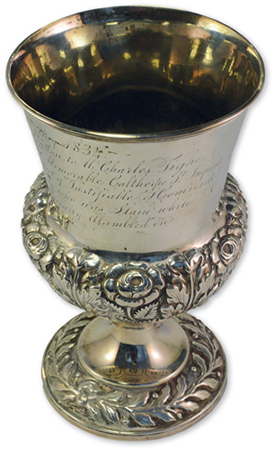
The silver loving cup, used for shared drinking, is reputed, according to museum records, to have originated in the early nineteenth century from a young Irish titled lady who had become attached to a man from a lower social class, and was then thrown out of her home by her family. She had become pregnant and was then deserted by her lover, who went on to marry another woman who was independently wealthy. In a reflection of the fate suffered by many disgraced young women in those days, she became a prostitute and then the madam of a brothel in Edinburgh.
About twenty years afterwards, she welcomed a party of students into the brothel, recognised one of them as the son of her former lover and murdered him out of revenge. The records state that she was hanged, her body being donated for the benefit of medical science, and subsequently it was her skull that was mounted in silver in the form of the loving cup.
In 1982, curator Bill Waddell had the cup examined by a scanning electron microscope at the Metropolitan Police Forensic Science Laboratory. This showed that stains inside the female skull were the sediment of red wine rather than blood. Marks on the front of the skull, previously believed to have been made by a saw used by a surgeon, or indeed by the woman mutilating her murder victim, were in fact compression marks consistent with a blow from a heavy blunt instrument.

1834
Silver cup presented to inquest jury members